+Search query
-Structure paper
| Title | Tubulin cofactors and Arl2 are cage-like chaperones that regulate the soluble αβ-tubulin pool for microtubule dynamics. |
|---|---|
| Journal, issue, pages | Elife, Vol. 4, Year 2015 |
| Publish date | Jul 24, 2015 |
 Authors Authors | Stanley Nithianantham / Sinh Le / Elbert Seto / Weitao Jia / Julie Leary / Kevin D Corbett / Jeffrey K Moore / Jawdat Al-Bassam /  |
| PubMed Abstract | Microtubule dynamics and polarity stem from the polymerization of αβ-tubulin heterodimers. Five conserved tubulin cofactors/chaperones and the Arl2 GTPase regulate α- and β-tubulin assembly into ...Microtubule dynamics and polarity stem from the polymerization of αβ-tubulin heterodimers. Five conserved tubulin cofactors/chaperones and the Arl2 GTPase regulate α- and β-tubulin assembly into heterodimers and maintain the soluble tubulin pool in the cytoplasm, but their physical mechanisms are unknown. Here, we reconstitute a core tubulin chaperone consisting of tubulin cofactors TBCD, TBCE, and Arl2, and reveal a cage-like structure for regulating αβ-tubulin. Biochemical assays and electron microscopy structures of multiple intermediates show the sequential binding of αβ-tubulin dimer followed by tubulin cofactor TBCC onto this chaperone, forming a ternary complex in which Arl2 GTP hydrolysis is activated to alter αβ-tubulin conformation. A GTP-state locked Arl2 mutant inhibits ternary complex dissociation in vitro and causes severe defects in microtubule dynamics in vivo. Our studies suggest a revised paradigm for tubulin cofactors and Arl2 functions as a catalytic chaperone that regulates soluble αβ-tubulin assembly and maintenance to support microtubule dynamics. |
 External links External links |  Elife / Elife /  PubMed:26208336 / PubMed:26208336 /  PubMed Central PubMed Central |
| Methods | EM (single particle) / X-ray diffraction |
| Resolution | 2 - 24.0 Å |
| Structure data |  EMDB-6390:  EMDB-6391:  EMDB-6392:  EMDB-6393:  PDB-5cya: |
| Chemicals |  ChemComp-SO4:  ChemComp-HOH: |
| Source |
|
 Keywords Keywords |  CHAPERONE / Tubulin cofactors / mirotubule dynamics / tubulin chaperones / Arl2 GTPase-activating protein TBCC / GAP activity / CHAPERONE / Tubulin cofactors / mirotubule dynamics / tubulin chaperones / Arl2 GTPase-activating protein TBCC / GAP activity /  beta helix / beta-sheets beta helix / beta-sheets |
 Movie
Movie Controller
Controller Structure viewers
Structure viewers About Yorodumi Papers
About Yorodumi Papers




